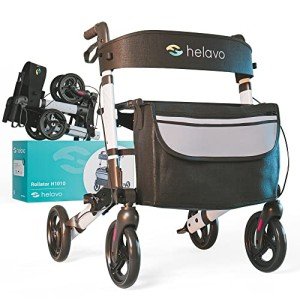The Comprehensive Guide to Heavy-Duty Walkers: Enhancing Mobility and Independence
In an aging society where people are significantly focused on preserving their self-reliance and mobility, heavy-duty walkers have ended up being vital mobility aids. These items offer improved support, stability, and sturdiness, making them ideal for much heavier individuals or those who need additional assistance while walking. In this extensive guide, we will look into the features, benefits, and numerous types of heavy-duty walkers, intending to offer a well-rounded understanding for those considering a purchase or those helping someone in requirement.
What is a Heavy-Duty Walker?
Heavy-duty walkers are particularly created for individuals requiring additional support and stability while walking. Unlike standard walkers, which may have weight limitations around 300 pounds, heavy-duty designs can accommodate people weighing anywhere from 300 to over 500 pounds. They are constructed with stronger products and include a wider frame for increased stability.
Key Features of Heavy-Duty Walkers
| Function | Description |
|---|---|
| Weight Capacity | Generally 300-- 500+ pounds, ideal for bigger people. |
| Frame Material | Built from heavy-duty aluminum or steel for strength. |
| Width and Height | Broader frames and adjustable heights for user comfort. |
| Footings | Developed with larger rubber pointers or wheels for improved grip and traction. |
| Seats and Accessories | Numerous models include padded seats and baskets for convenience. |
Advantages of Using Heavy-Duty Walkers
Heavy-duty walkers offer various benefits beyond easy mobility:
- Enhanced Stability: Their sturdy design prevents tipping and supplies a secure base, lowering the threat of falls.
- Improved Confidence: With the included support, users often feel more secure and positive when walking, encouraging mobility.
- Personalization: Many heavy-duty walkers have adjustable heights and configurations, catering to the specific needs of users.
- Practical Design: Several designs come with built-in seats, storage spaces, or multipurpose features that make carrying individual items easier.
- Healing Benefits: Regular usage of walkers can assist enhance flow and promote a more active lifestyle, which is important for general health.
Common Conditions Benefiting from Heavy-Duty Walkers
| Condition | Description |
|---|---|
| Weight problems | Additional support for heavier users needing help with mobility. |
| Arthritis | Offers stability and lowers strain on joints while walking. |
| Post-Surgery Recovery | Assists with rehabilitation and progressive return to mobility. |
| Neurological Conditions | Supports those with balance or coordination issues. |
| Elderly Mobility Challenges | Uses the elderly a much safer ways of maintaining independence. |
Types of Heavy-Duty Walkers
When selecting a heavy-duty walker, it's essential to think about the specific needs and lifestyle of the user. Below are the commonly readily available alternatives:
- Standard Heavy-Duty Walker: Simple yet reliable, these walkers include a robust frame without wheels. Best for static support.
- Rollator Walker: Equipped with wheels, a brake system, and typically a seat, these walkers aid users in moving at a faster speed while permitting fast rests.
- Front-Wheeled Walker: This type has 2 wheels at the front and sturdy legs at the back. It provides more mobility than a standard walker while maintaining stability.
- Combination Walker-Transport Chair: These multifunctional devices can be utilized as a walker and quickly transformed to a transport chair for those needing more assistance.
- Portable Heavy-Duty Walker: Lightweight however sturdy, these walkers are developed for ease of transport, perfect for those who travel typically.
Comparative Chart of Heavy-Duty Walkers
| Type | Stability | Maneuverability | Mobility | Seat Available |
|---|---|---|---|---|
| Standard Heavy-Duty | High | Low | Low | Optional |
| Rollator | Medium | High | Medium | Yes |
| Front-Wheeled | Medium | Medium | Medium | No |
| Combination Chair | Medium | Low | Low | Yes |
| Portable Heavy-Duty | Medium | High | High | No |
Regularly Asked Questions (FAQs)
Q1: How do I pick the ideal heavy-duty walker for me?
- Weight Capacity: Ensure that the walker exceeds your weight to make sure safety.
- Height: Choose a walker with adjustable height features to fit your body size.
- Use: Consider your specific requirements-- whether you require a seat, extra storage, or the ability to browse numerous surfaces.
Q2: Are heavy-duty walkers covered by insurance?
Some insurance coverage suppliers might cover the cost of heavy-duty walkers, especially if recommended by a health care professional. It's vital to inspect with your insurance coverage service provider for specifics regarding coverage.
Q3: How do I preserve my heavy-duty walker?
Routinely inspect the walker for wear and tear. Clean My Mobility Scooters and wheels to prevent accumulation. In addition, check the brakes and adjust the height as necessary.
Q4: Can I utilize a heavy-duty walker on uneven terrain?
Some heavy-duty walkers, particularly rollators with bigger wheels, are developed for different terrains. Nevertheless, standard walkers may not perform also on irregular surface areas.
Q5: When should I consider using a heavy-duty walker?
If you experience trouble keeping balance, your weight exceeds the capacity of basic walkers, or you have mobility limitations due to medical conditions, a heavy-duty walker might be proper.
Heavy-duty walkers are important mobility help that provide many benefits, especially for individuals who need more support. They are essential in promoting independence, safety, and confidence while navigating everyday life. By comprehending the various types, features, and conditions they can help with, users can make informed choices in their quest for increased mobility and lifestyle.
For those thinking about a heavy-duty walker, considering personal requirements and choices will cause a more satisfying and secure walking experience. Whether for yourself or a liked one, comprehending the complexities of heavy-duty walkers will play an essential role in fostering mobility and independence.

